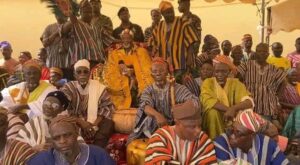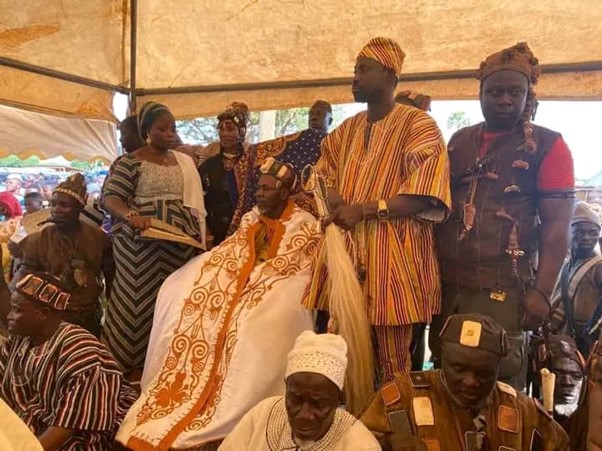The Overlord of Gonjaland, His Royal Majesty Yagbonwura Bii-Kunuto Jewusoale I, paid a historic courtesy visit to the Overlord of the Dagbon Kingdom, Ya Na Mahama Abukari II, at his palace in Yendi on Sunday.
The visit, the first of its kind, aimed to foster unity between the Gonjas and Dagbon and promote development in the Northern and Savannah Regions.
The event was marked by excitement and jubilation across both Dagbon and Gonja lands. The youth from both sides expressed optimism that the visit would ensure lasting peace and cooperation in the regions. The meeting also showcased both kingdoms’ rich cultural heritage as the two leaders symbolically smoked a peace-pipe, reinforcing their commitment to development and unity.
Despite centuries of neighbouring each other, no overlord from either the Dagomba or Gonja kingdoms had ever visited the other – making this visit a historic milestone.
The Yagbonwura’s visit is seen as a significant step in teaching youths the importance of unity for economic development. Sources from the Yagbonwura’s palace revealed that the king also plans to pay a courtesy call on the Overlord of Mamprugu Traditional Area, Nayiri Na Mahami Bohigu Sheriga.
Brief history of Dagbon
The kingdom of Dagbon, one of the oldest and most organised traditional kingdoms in Ghana, was founded by the Dagomba people in the 15th century. It was established by the warrior Tohazie, also known as the ‘Red Hunter’, from Zamfara in northern Nigeria.
After leading his people and successfully waging wars against rival villages, Tohazie married a Malian princess, Pagawubga, with whom he had a son named Kpogon-umbo. Conflicts with the rising Mamprugu Kingdom eventually led to the separation of Dagbon, Mamprugu and Nanung as distinct entities.
Initially, Dagbon’s capital was Yani Dabari; but around 1700, it was moved to the present-day city of Yendi due to continuous wars with neighbouring kingdoms. Under rulers like Naa Zangina, Dagbon became a major trading partner in the region – trading salt, kola nuts and slaves with the Dyula, Hausa and other Sahelian kingdoms.
In the late 19th century, Dagbon faced threats from European colonial powers – resulting in its division between German Togoland and the British Gold Coast colony in 1899. Despite colonisation, Dagbon maintained a high degree of autonomy and organisation.

Brief history of the Gonjas
The Gonja people established their kingdom in northern Ghana during the 17th century. The Gonja Kingdom was founded around 1675 by Sumaila Ndewura Jakpa, a warrior from the Mande region of West Africa.
Jakpa led a group of horsemen and conquered the lands that became the Gonja Kingdom, establishing his capital at Yagbum. Jakpa divided the kingdom among his sons, who governed the main provincial towns like Tuluwe, Bole and Salaga. The Gonja Kingdom became a major trading hub, linking the gold and kola nut-producing regions of the Volta basin to Sahelian trade networks.
In the late 19th century, the Gonja Kingdom faced threats from European colonial powers. After conflicts with the Germans, British and French, the kingdom was eventually divided between German Togoland and the British Gold Coast colony in 1899. Despite colonisation, the Gonja people preserved their autonomy and cultural heritage, including traditional festivals, dances and the Dagbani language.










